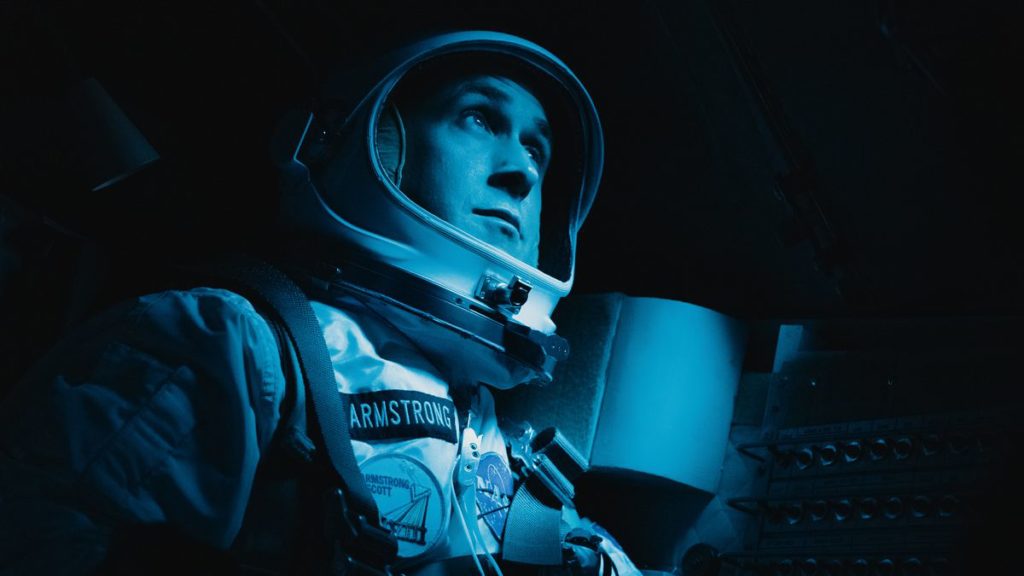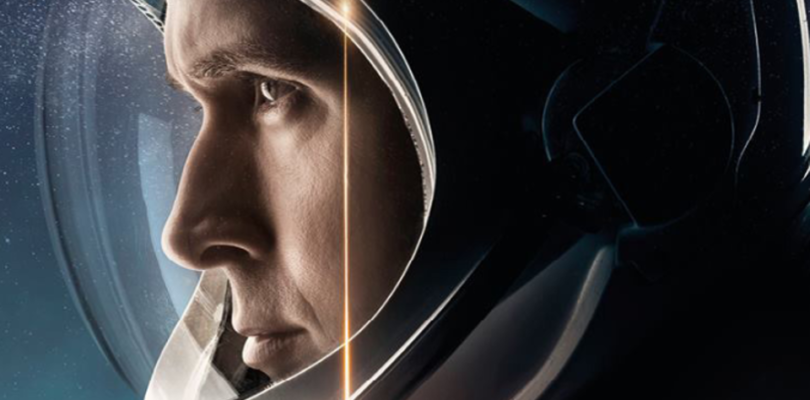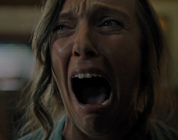By Noel Vera
First published in Businessworld 10.19.18
First Man goes inward. It is almost Bergmanesque in its attempt to probe Armstrong’s hermetically closed psyche. Director Damien Chazelle manages a few startling visual and aural effects along the way
You need to keep reminding yourself: Damien Chazelle’s adaptation of James Hansen’s biographical book First Man is not The Right Stuff and astronaut Neil Armstrong (played by Ryan Gosling) is no Chuck Yeager nor was it–or he–meant to be. Question: does it still manage to stand on its own four radically redesigned fins?
Where Stuff had sweep and humor and drive Man goes inward, is almost Bergmanesque in its attempt to probe Armstrong’s hermetically closed psyche. Definitely a courageous relatively uncommercial attempt, and Chazelle manages a few startling effects along the way–the camera inside the capsule for one capturing the sense of being trapped inside a tiny space, not the least because Chazelle takes care to show us the process of entombment: the long walk up and across the gantry, the awkward climb inside, the squeezing into seats, the heavy doors and large bolts being tightened into place (vacuum-sealed if you like for maximum security).
Then–and this may be the director’s best effect–you listen: groans and keening of metal under stress, not just by the bending and twisting caused by wind but by the extremes of heat and cold (Liquid kerosene is kept at -53 F, liquid oxygen at -361 F, liquid hydrogen at an enamel-shattering -423 F; the engine when fired achieves an exhaust temperature of 5,800 F). You’re constantly made aware by the concerto of creaks that they sit atop a thirty-six story building wrapped in flimsy metal sheeting filled almost to the gills with explosive fuel. Not bad from a filmmaker who previously made a drumming picture (Whiplash) and a musical (La La Land)–someone you might say is constantly obsessed with the emotional and dramatic impact of a sound.
Beyond the sounds is Gosling: if you need an introverted actor who sucked the oxygen out of any room he happens to stand in he’s your man, and that’s only halfway meant to be a slam. He’s in the same school of interiorized somewhat narcissistic acting as Robert Pattinson and Keanu Reeves, who specialize in reacting to the most outrageous situations with a grunt and grimace, a kind of minimalist response system that at its best suggests a character obsessed with controlling the face he presents to the world at worse is a deadly bore. Armstrong you quickly realize is all about the Right Stuff: he strives to maintain that even strain, and any crack on his impassive facade is a failure a crisis a betrayal even.
As Armstrong’s first wife Janet Shearon (the film stops shortly after the moon shot), Claire Foy at first shares her husband’s impassivity, plays the classic role of supportive wife and mother with ho-hum competence. But somewhere along the way Janet has her fill of Neil’s professional demeanor and in a scene that may have been added by Chazelle and screenwriter Josh Singer, may have been taken from Hansen’s book (I have not read the source material) posits a scene where Janet literally has to corner Neil and force him to talk to his kids before going on what is basically a suicide mission. An uncomfortable and yet horrifyingly funny moment that Foy makes the most of, because it’s the one point where she’s allowed to cut loose and assert her authority. Foy makes a fine foil for Gosling if you like, who’s free to spread wings and soar.

Or at least glide along on cruising speed, at optimal attitude. In the end you miss the social context and satire Stuff provided, the kind of broad canvas of the United States that director Philip Kaufman channeling Tom Wolfe painted for his winged epic, a suitably colorful backdrop against which his equally colorful characters can strike heroic poses and fling themselves at the sky. You miss the humor and while it’s possibly too much to ask that Armstrong himself display some form of freezedried wit the film might have packed some for the trip, as means of contrast and comparison, smuggled up perhaps by his traveling companions. At one point in his novel Tom Wolfe witheringly sums up the famous astronaut as a ‘computer:’ when asked a question Armstrong would hesitate, and out of his mouth would stream “a sequence of long, quiet, perfectly formed, precisely thought-out sentences, full of anistropic functions and multiple encounter trajectories”–that brief description seems to convey what a conversation with Armstrong can be like better than this film.
Beyond Foy and Gosling the rest of the astronauts are presented as a largely anonymous bunch, a remarkable feat on Chazelle’s part considering how outsized some of these personalities can be. I’m looking especially hard at Buzz Aldrin, ably played by Corey Stoll with the suitable amount of spark: given enough screen time and interaction he could have been Janet’s equivalent at work, constantly poking and probing Armstrong, trying to pry apart the walking computer’s tight-sealed CPU. Aldrin might have succeeded might not, but we would have been at least partly enlightened by the attempt.
A note on the visual style: Chazelle does well conveying an aural sense of what it’s like being stuffed into a capsule (Tom Wolfe’s famed phrase ‘spam in a can’) and calibrates his camerawork accordingly, the lenses in close and personal, giving you the sense that outside of the already crowded frame there’s just not much room to spare (in a conical container, spinning through the vast reaches of outer space)–though why having noted all that does he have to apply the same cramped shaky-cam look to the rest of the picture? Some of the film is set in the Mojave Desert and Houston, Texas; maybe some sense of the expansiveness of the various locations could have given the audience a bit of relief in between all the claustrophobic capsule action and (again) emphasized via contrast the confined nature of the spacecraft. The film may be about Armstrong but it doesn’t have to assume his narrow-focus viewpoint all the time.
Chazelle does cut loose once, late in the film, blowing a good chunk of his budget on the Apollo 11 takeoff–though impressive it doesn’t quite touch the grandeur of some of Philip Kaufman’s more spectacular launches. Kaufman mixed documentary footage and large-scale miniatures, resorting to wire rigging to simulate flight as opposed to standard-issue digital effects. Digital was admittedly primitive back in the 90s–but as a result, Kaufman’s film looks more distinctive now than back then, looks come to think of it the way Chazelle’s film sounds. Could we marry Kaufman’s retro look to Chazelle’s soundtrack in yet another epic about space flight? Unlikely, considering that both films bombed at the box-office–but it’s an idea to consider.
In the film’s climactic moon landing attempt (skip the rest of this paragraph if you haven’t seen the film!) we’re presented with an (entirely fictional) conceit: that Armstrong was perhaps emotionally traumatized by the death of his daughter Karen, that he thought of her when he was on the lunar surface–possibly left her keepsake in a nearby crater–and that his time of solitude on the moon was a means of making peace with her memory. I don’t know; Chazelle and Singer feels like a bit of a cheat: the gesture doesn’t come out of anything we know of the man, it follows the too-familiar contours of biopic territory, where a man’s defining moment also resolves his life’s struggle (and here a quick peek at Singer’s filmography shows him perfectly capable of committing said crime), and it compromises the film’s opaque surface, which by this time has acquired a muleheaded integrity. The story ends just when Armstrong’s life is getting really interesting: this taciturn man confronted with the lifelong glare of fame, having to contend with requests for autographs, invitations to interview, offers of talk shows product endorsements giveaways and so on. He deals with them as he always has, with that mildly bizarre stubborn terseness with which he deals with everything.
First Man isn’t quite Stuff–lacks the latter’s bountiful variety and self-critical spirit. But it has its own look and feel (unlike say Ron Howard’s terminally generic Apollo 13) that generates its own understated drama; it eventually manages to take off, describing its own suborbital parabola, ending in a muted if memorable splashdown.


